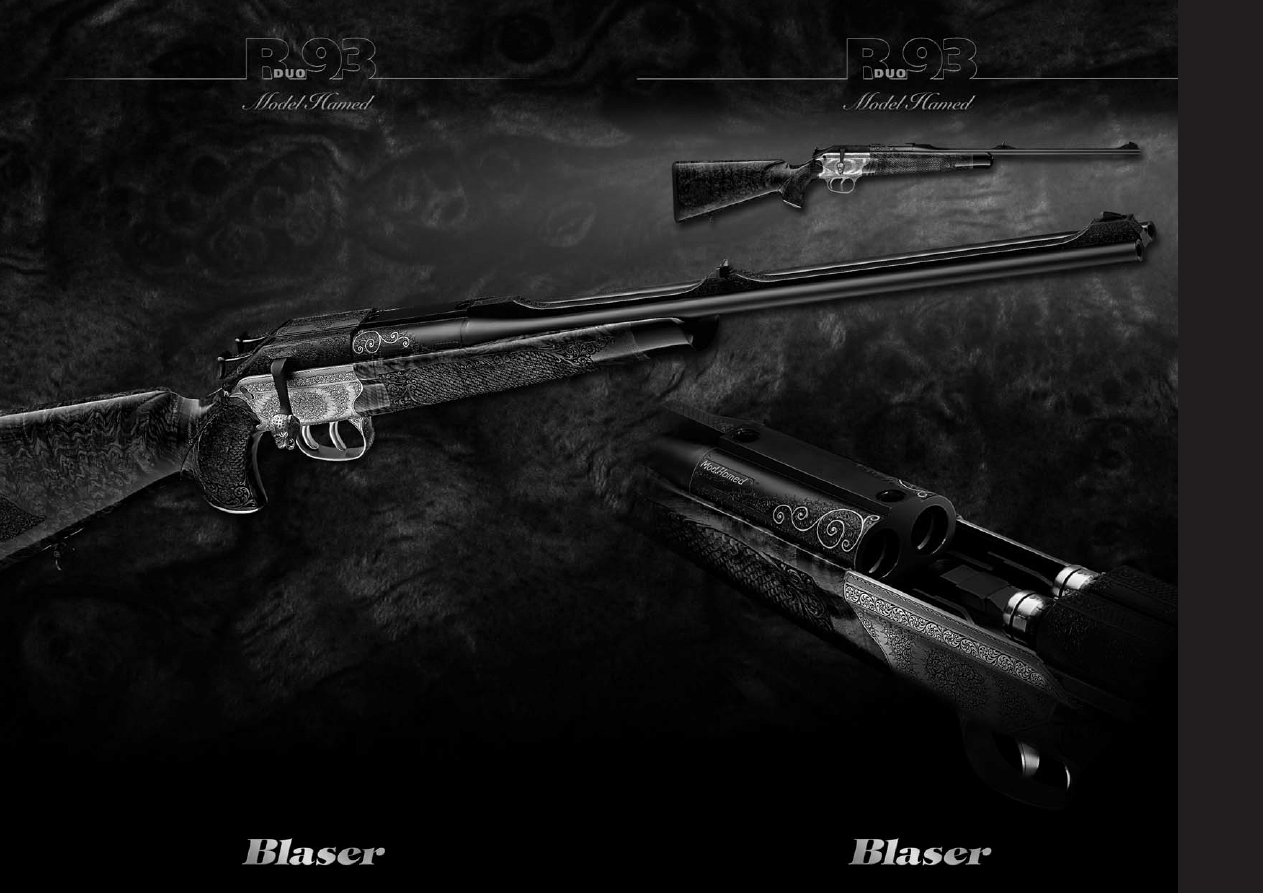
Instruction Manual
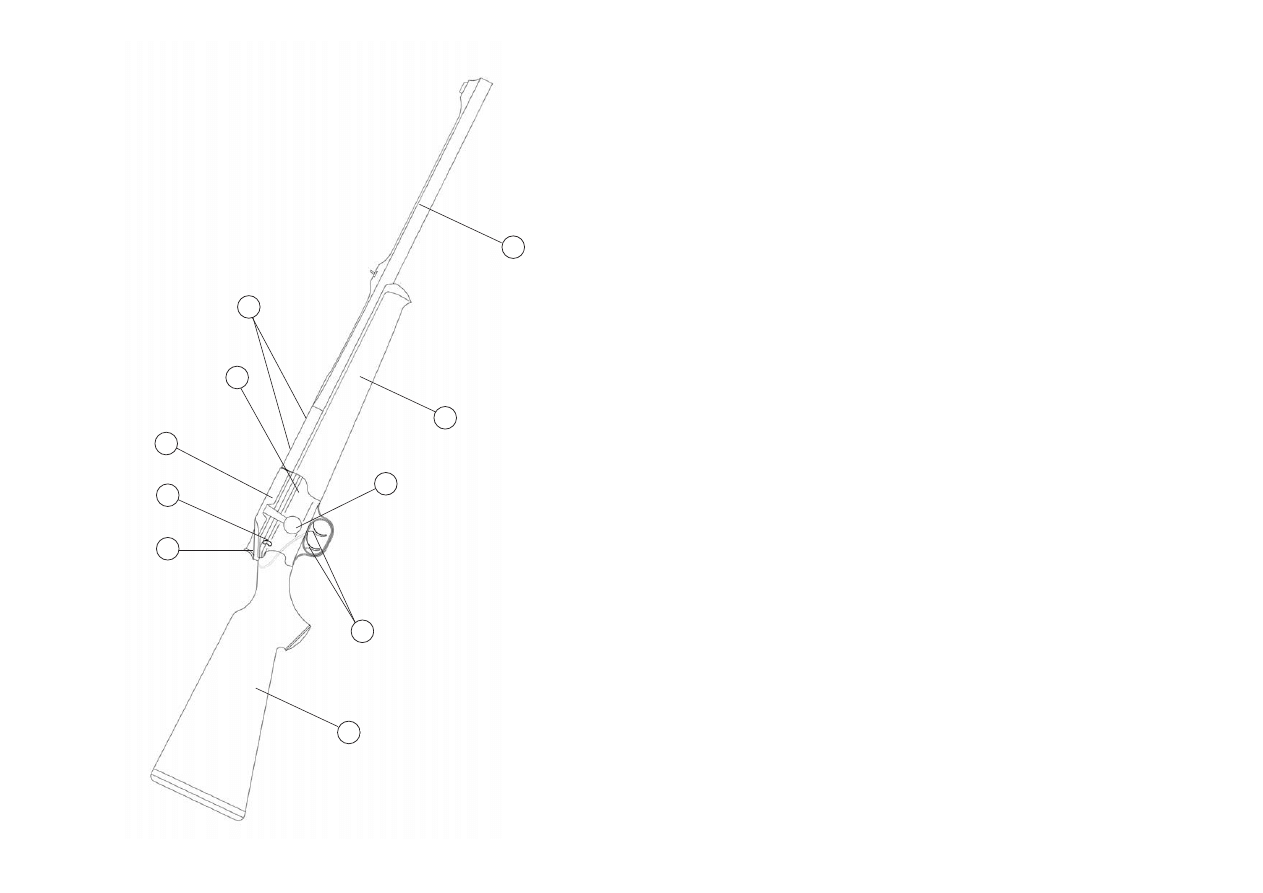
Contents
3
Page
Description of parts
2/3
General Safety Rules
4/5
1. Assembly, Disassembly
6/7
2. Safety and Bolt Handle Lock
8/9
3. Loading the Rifle
10
4. Firing
11
5. Unloading
12
6. Removing and Installing Bolt Assembly
12
7. Exchanging Barrel Set
13
8. Exchanging the Bolt Head
14/15
9. Removal of Forearm /Exchange of Forearm
16
10. Open Sights
16
11. Mounting of Scope
17
13. Calibre Groups
18
15. Care and Maintenance
18
16. Warranty Conditions
19
2
Description of parts
1
Safety slides (cocking slides)
2
Bolt Stop
3
Bolt Assembly
4
Receiver
5
Barrel Set
6
Forearm
7
Bolt handle
8
Triggers
9
Buttstock
10
Seat for scope mount
1
2
3
4
10
5
6
7
8
9

5
4
General Safety Rules
General Safety Rules
Your new Blaser bolt action rifle model R 93
is characterised by special design features,
making it very different from other bolt
action rifles.
The enhanced safety features of your Blaser
rifle should never induce you to ignore the
necessary care and legal provisions with
respect to handling arms. Please check first,
whether you have the correct operating
instructions: the model R 93 and the calibre
are indicated on left side of the barrel, on its
lower end.
CAUTION:
Please read these operating instructions
completely, before using the rifle. Only
hand on the rifle together with the operating
instructions.
Please ask your specialised dealer for an
in-depth explanation of your rifle and
instruction in its use, as a supporting
measure to these operating instructions.
General safety rules
for handling firearms
– Ensure that firearm and ammunition never
pass into the hands of unauthorised
persons.
– Always keep firearm and ammunition se-
parate, in a secured unit and inaccessible
to unauthorised persons.
– Observe applicable legal provisions
for carrying and storing arms and
ammunition.
– Familiarise yourself thoroughly with the
handling of your firearm and practise all
functions and actions with the firearm
unloaded, before starting to carry and
use it.
– Consider every firearm as loaded and
ready to fire, unless you have convinced
yourself of the contrary by opening
the action and checking the chamber
(barrel). Even when unloaded, a firearm
has to be handled like a loaded firearm.
– During any handling, always hold the
muzzle in a direction where you can
neither jeopardise nor damage persons
or property.
– Before loading the firearm, always check,
whether there are oil residues or other
foreign matters in the chamber or barrel.
Oil residues in chamber or barrel may
cause distinct shifts in the point of impact!
Foreign matter in the barrel (e.g. water,
snow, soil) may cause a detonation of
the barrel, leading to severe injuries of
the shooter or persons in the vicinity!
Ensure that no foreign matter can enter
the barrel, also during use!
– Only use ammunition which meets the CIP
requirements, in particular with regards to
the maximum gas pressures P
max
according
to CIP regulations. Every Blaser rifle is
controlled and tested by the state proof-
house according to the requirements of
the proofing-law and -regulations, using
proof cartridges exceeding the maximal
allowed gas pressure P
max
by a minimum
of 30%. If gas pressures exceed proof-level,
the safety of the user and/or third parties
can no longer be guaranteed. The same
applies to cartridge cases, where the seal
function is no longer correct through
obturation.
– Load your firearm only immediately
before use.
– Disengage from safe position (cock) your
firearm only immediately before shooting.
Hold barrel into a direction out of danger
during disengaging (cocking).
– Check the surrounding area, before
every shot.
– Point your firearm only at a target,
which you have clearly identified.
– Only put your finger on the trigger,
when you want to shoot.
– Only fire a shot, when a secure back
stop exists.
– When a cartridge fails, wait approx.
60 seconds before opening the action,
to avoid danger through hang-fire.
– Wear hearing protection during shooting.
Unload your firearm:
– before
crossing
obstacles,
– before climbing and leaving raised hides,
– before entering a building,
– before climbing into a vehicle,
– before entering a built area,
– and also, when you lay down or
hand on the firearm temporarily.
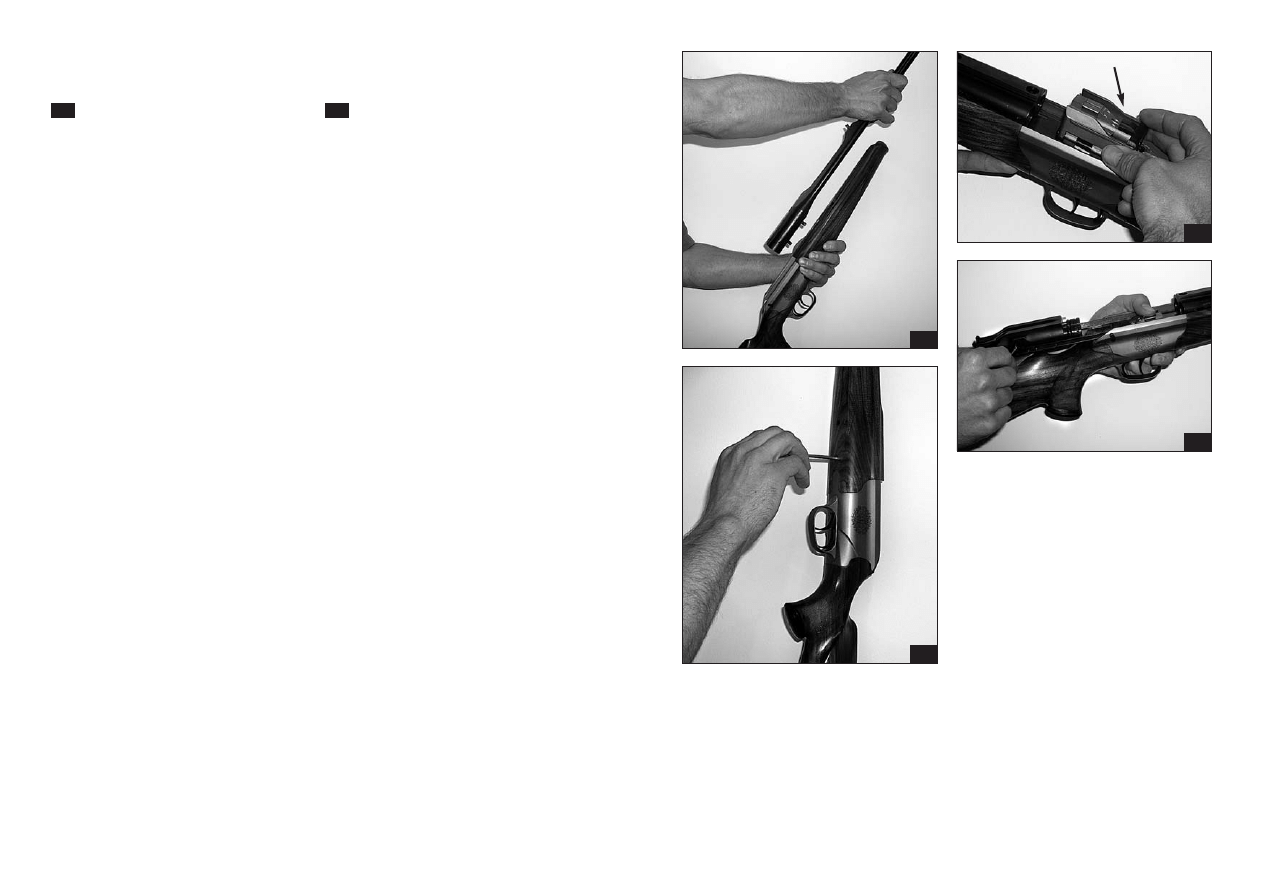
7
6
1.1.
1.1.
1.1.
1.1.
1. Assembly, Disassembly
Assembly
• Insert barrel set into receiver, with muzzle
pointing upwards, and hold it there.
• Fasten the two barrel fastening nuts hand
tight with the Allen key provided (SW4).
Do not use extensions!
• Insert magazine into magazine well and
press it downwards.
• Carefully put bolt with the two guide slide
ends onto rear end of receiver, parallel to
bolt guide rail.
• Press magazine downwards and slide bolt
assembly forward, into receiver.
CAUTION:
When mounting the bolt assembly, the bolt
handle has always to be in its rear position.
I.e. at an angle of approx. 45°. If the bolt
handle is in an almost vertical position,
mounting of the bolt assembly is not
possible. Turn the bolt handle back into the
45°-position, until it engages.
CAUTION:
Care has to be taken during assembly, that
barrel, bolt assembly and magazine are
appropriate for the calibre.
1.1.
Disassembly
• Push both safety slides slightly forward
with your thumb (approx. 2mm); at the
same time, turn bolt handle backwards
with your index and middle finger (unlo-
ck), then pull bolt assembly back in a
straight line.
• Unload rifle (refer to Para. 5).
• Push in bolt stop and hold it there, at the
same time, pull bolt assembly out towards
the back, using your other hand.
• Loosen the two barrel fastening nuts with
the Allen key provided (SW4).
• Remove barrel set.
1.2
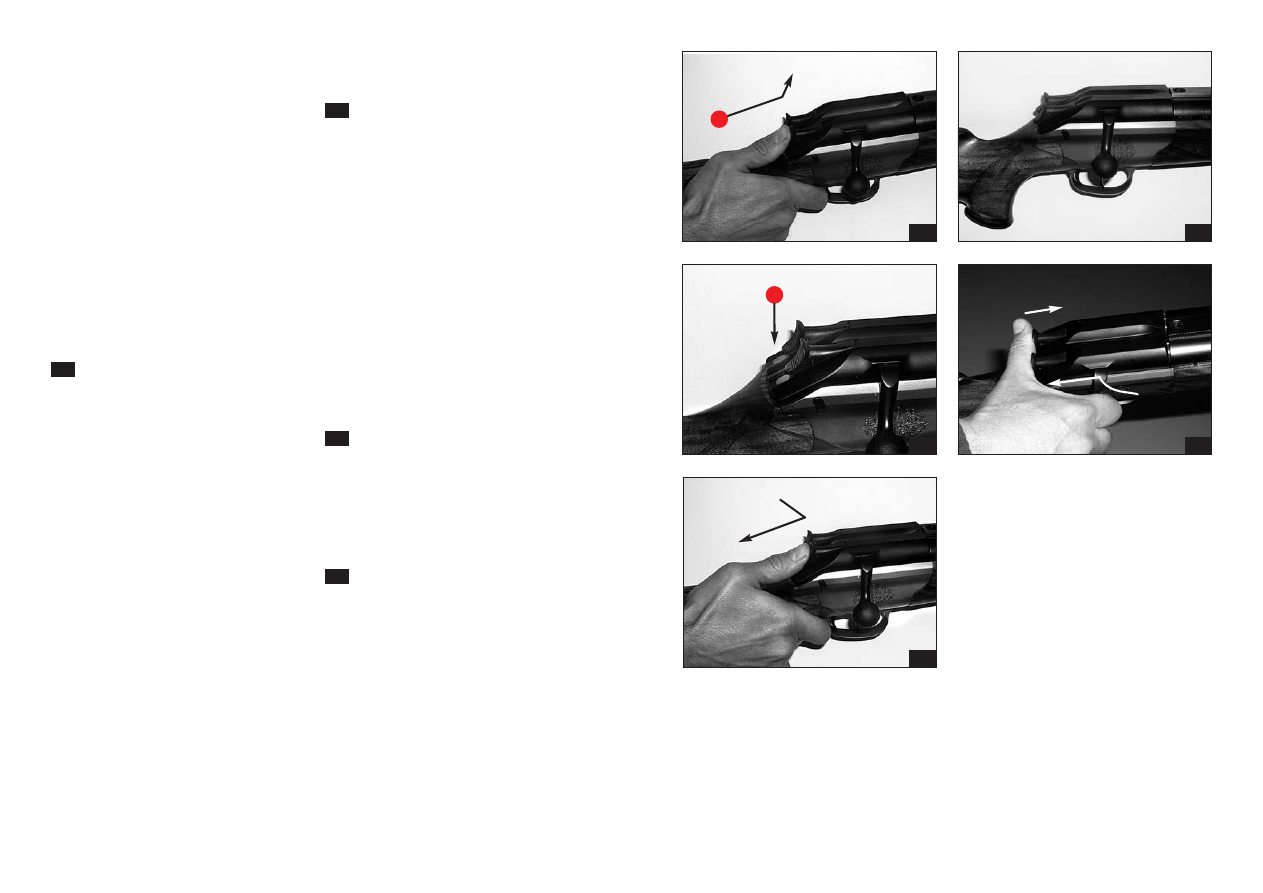
8
9
2.1.
2.1.
2.2.
2.3.
2.4.
2. Safety and Bolt Handle Lock
Safety system
The safety system of the Blaser bolt action
rifle model R 93 Duo is based on uncocked
firing pin springs: the firing pin springs are
cocked with the safety slides immediately
before the shot. When repeating, the rifle
is cocked again automatically.
In its secured (uncocked) position, the
bolt handle is also blocked to prevent un-
intentional opening of the bolt assembly
when moving the rifle, provided that the
handle was fully closed.
Disengaging from safe position
(cocking)
• Push both safety slides forward powerfully
with your thumb, all the way to the stop,
and lift thumb off. Doing so, the safety
slides lock into their cocked position.
• Red dots become visible behind the
safety slides as a signal.
The rifle is now disengaged from safe
position (cocked).
2.1.
Returning to the safe position
(locking/uncocking)
• To put the rifle on "safe”, push the safety
slides forward/downward with your thumb
(unlocking) and let them slide back into
their starting position (the red signalling
dots are not visible any more).
CAUTION:
Under no circumstances should you put
your fingers into the triggers when disenga-
ging (cocking) or locking (uncocking) your
rifle (you may be used to do this from rifles
with exposed hammers).
This would trigger the shots, when the rifle
is loaded!
Bolt handle lock
• Prevents unintentional opening of the bolt
assembly. It becomes active automatically,
when the rifle is put on "safe” (uncocked)
and fully locked.
Opening the locked
(uncocked) rifle
• Push the safety slides slightly forward with
your thumb (approx. 2mm).
• At the same time, turn bolt handle back-
wards with your index and middle finger
(unlock), then pull bolt assembly back in
a straight line.
2.4.
2.3.
2.2.

11
10
3. Loading the Rifle
4. Firing
Loading
• Move safety slides (cocking slides) back
(lock/uncock).
• Open bolt assembly. (Refer to Para. 2.4)
• Remove oil from barrel and chamber and
check for foreign matter.
• Convince yourself under all circumstances
that the ammunition corresponds with the
calibre of your rifle.
• Put cartridges into the magazine and push
them down through the magazine lips
powerfully - if necessary with both thumbs.
Capacity of the magazine:
3 Cartridges on the left side
3 Cartridges on the right side
• Two additional cartridges can be inserted
into the chamber.
• Push cartridges in magazine down with
your thumb; push the bolt assembly all
the way to the front with your other
hand, engaging it.
PLEASE CHECK:
Red dots not visible, bolt handle in front
position. The rifle is now loaded, put on
"safe” (uncocked) and locked against
unintentional opening.
3.1.
CAUTION:
As long as the safety slides remain in their
forward, cocked position, the bolts of the
rifle will cock automatically with each
repetition. When you do not want to
continue shooting, lock (uncock)
immediately again by letting the safety
slides slide backwards.
CAUTION:
The Blaser bolt action rifle model R 93 Duo
is equipped with a direct pull triggers. Its
setting can and may only be changed at the
factory. Please check the trigger regularly for
smooth movement, with the rifle unloaded
and uncocked.
Hardened oil and/or contaminations may
affect proper functioning of the triggers
and cause malfunctions.
Firing and repeating
• Cock the rifle by pushing the safety slides
forward.
• Sight at target and fire.
• Reloading (repeating): Pull bolt assemblies
at bolt handle back all the way to the stop
and then push all the way forward again.
(With some practise, this can be done
during pointing.)
NOTE:
If the bolt handle is not pushed forward
all the way to the stop, the cartridges will,
for safety reasons, be unable to ignite.
4.1.
WARNING:
• Do not move the safety to the „off Safe“
position until you are ready to fire.
• When you interrupt or finish firing, move
the safety slides immediately backwards in
the „on safe“ position.
• In only one shot is fired the assembly
remains cocked. Danger!
• If the second shot is not fired immediately,
ensure the gun is uncocked before
storing!
WARNING:
• If only one shot is fired and then repeated,
the shell and the live round will be
extracted!
• Please secure the extracted live round ans
thereby ensure that it does not land in
unauthorized hands.
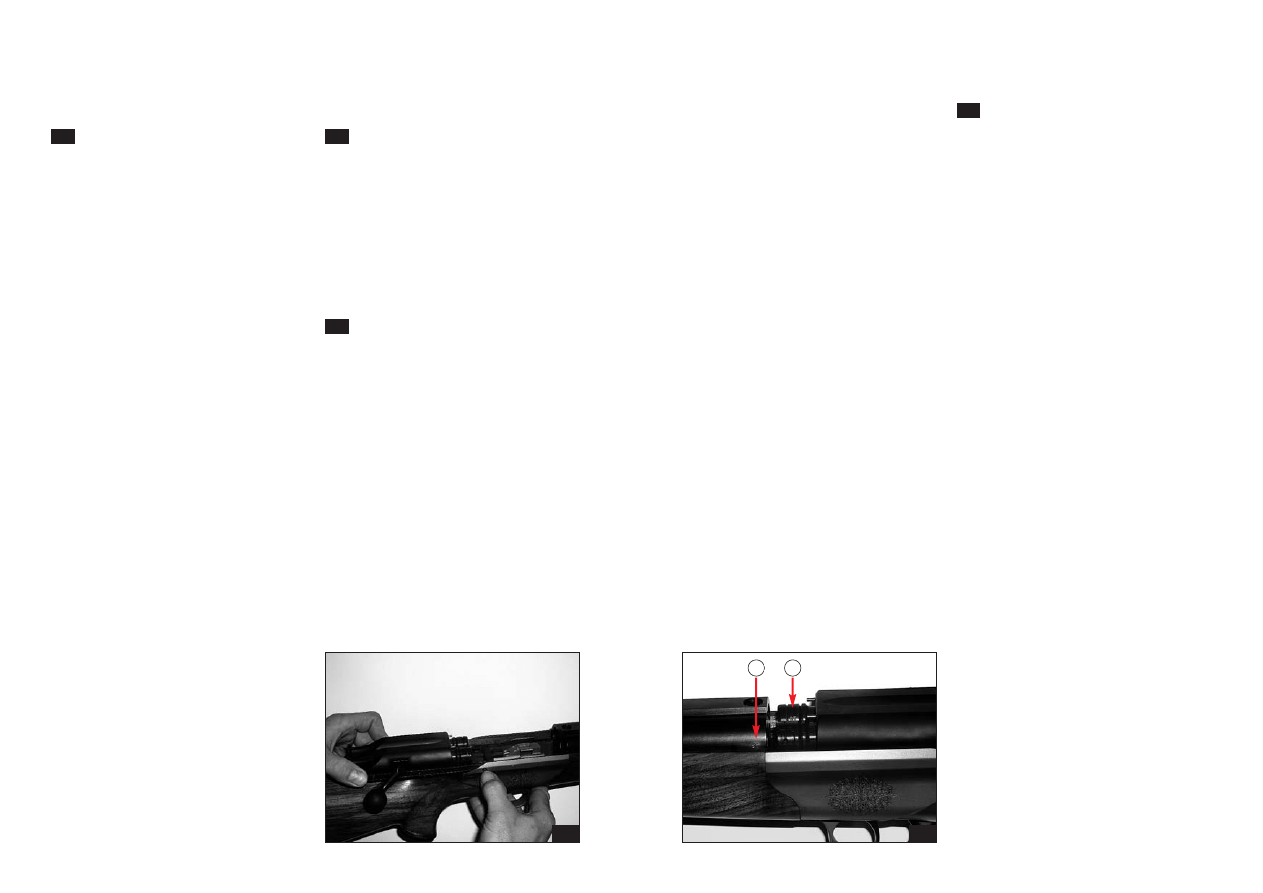
13
12
5. Unloading
Unloading
• Lock (uncock) the disengaged (cocked) rifle
by letting the safety slides move back-
wards with your thumb.
• Open bolt assembly and pull it back (refer
to Para. 2.4), at the same time, the
cartridges are extracted and ejected.
• Push cartridges remaining in the magazine
forward with your thumb (or the bolt
assembly), until they jump out of the
magazine lips. Remove cartridges.
• Make sure that barrels and magazine are
empty.
5.1.
6. Removing and
Installing
Bolt Assembly
Removing bolt assembly
• Unload rifle.
• Pull opened bolt assembly all the way
back.
• Now push bolt stop in and hold it in this
position. At the same time, pull bolt
assembly out towards the back, with
your other hand.
Installing bolt assembly
• Push magazine in the receiver all the
way down and hold it in this position.
• Carefully put bolt assembly with the two
guide slide ends onto rear end of receiver,
parallel to bolt guide rail.
• Slide it forward into the receiver.
6.2.
6.1.
6.1.
7. Exchanging Barrel Set
There are 2 calibre groups (refer to Table
on p. 18). When changing from one calibre
group to the other during a barrel exchange,
the bolt head has to be changed as well, so
that it corresponds to the calibre group of
the interchangeable barrel set actually
mounted. Please refer to the table on page
18 for proper allocation of suitable inter-
changeable barrel sets. Furthermore, bolt
heads and barrel sets are imprinted with a
symbol for the respective calibre group.
These markings have to agree after assem-
bly is completed.
Within one calibre group, barrel sets may be
interchanged at random, without having
to exchange the bolt head.
Calibre groups:
Standard
stamp ST
Magnum
stamp MA
Make sure that a magazine of the correspon-
ding calibre is installed, when performing a
barrel exchange. The calibre denominations
are marked on the side of the magazine.
Exchanging the barrel set
• Unload rifle.
• Remove bolt assembly.
• Remove magazine (possibly, the scope
has to be removed for this, refer to Para.
12.2 and/or 13.2).
• Loosen both barrel set fastening nuts
completely, using Allen key (SW4). The
nuts remain in their guide rails and cannot
get lost.
• Lift barrel set out of receiver.
• Put exchange barrel set into its channel
inside receiver.
• Fasten the two barrel set fastening nuts
hand tight with the Allen key.
• Insert the magazine corresponding to the
calibre of the exchange barrel set into the
magazine well.
• Check, whether the calibre group marked
on the bolt head ("ST", "MA", refer to
Para. 7 and Fig. 7.1.) corresponds with the
calibre group of the exchange barrel set.
• If the bolt head in the receiver has to be
exchanged: refer to Para. 8.
NOTE:
Always ensure that the barrel set channel is
clean! Excessive oil or gun grease between
barrel and receiver has a negative effect on
the precision of the gun.
7.1.
7.1.
ST
ST
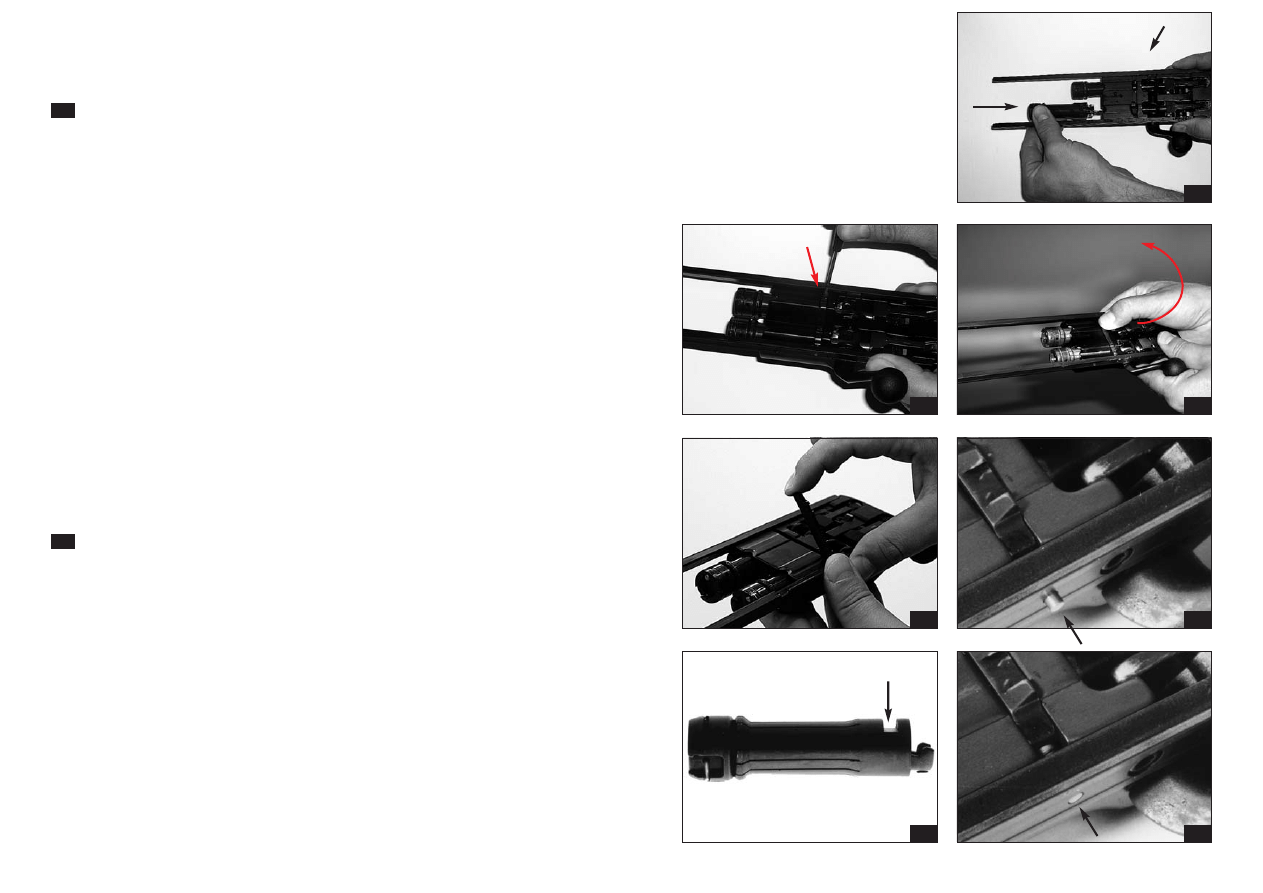
15
14
8. Exchanging the Bolt Heads
Removing the bolt heads
You should best ask your specialised
dealer for a demonstration of this
process.
• Unload rifle.
• Remove bolt assembly.
• Deposit bolt assembly on a flat surface,
with the lower side pointing upwards.
• Use a small screw driver or similar object
to push the retaining latch to the left,
and swivel it up.
• Hold the retaining latch with your thumb
and index finger and push it, against the
pressure of the spring, all the way to the
left, until it touches the left rail. Now pull
the bolt heads out towards the front,
using your other hand.
Installing bolt heads
• Take the bolt heads to be newly installed
and match the two cut keyways of the
expanding shells and bolt head by turning
the two parts against each other.
• Lift the retaining latch in the bolt housing.
• Now push the bolt heads to be installed,
with the cut keyways pointing exactly up-
wards, over the firing pin until it touches
the stop, and hold it in this position.
8.2.
8.1.
NOTE:
In order to facilitate threading in, you
should move the firing pin nut at the back
up and down with the thumb of your other
hand, during this process.
• Tilt retaining latch down again and engage
it against the pressure of the spring.
CAUTION:
If the retaining latch is not locked properly, a
signalling pin emerges at the exterior side of
the rails.
• The bolt assembly can only be inserted into
the receiver, when the signalling pin has
disappeared and the retaining latch has
thus been locked properly.
CAUTION:
• The right bolt head ejects the shell or
cartridge to the right and the description
with the calibre group is marked with an „R“.
• The left bolt head ejects the shell or
cartridge to the left and the description with
the calibre group is marked with an „L“.
• Bolt head marked „L“ should be inserted
into the left side of the bolt assembly, bolt
head marked „R“ into the right side of the
bolt assembly only.
CAUTION:
The expanding shells enclosing the bolt
head, being an essential part of the bolt
assembly, is secured with a rivet. It is strictly
forbidden to loosen this rivet! Removal of
the expanding shell will, when a shot is fired,
inevitably cause the bolt assembly to be
blown out and thus lead to lethal danger for
the shooter or bystanders!
8.1.
8.1.
8.2.
8.2.
8.2.
8.2.
8.2.
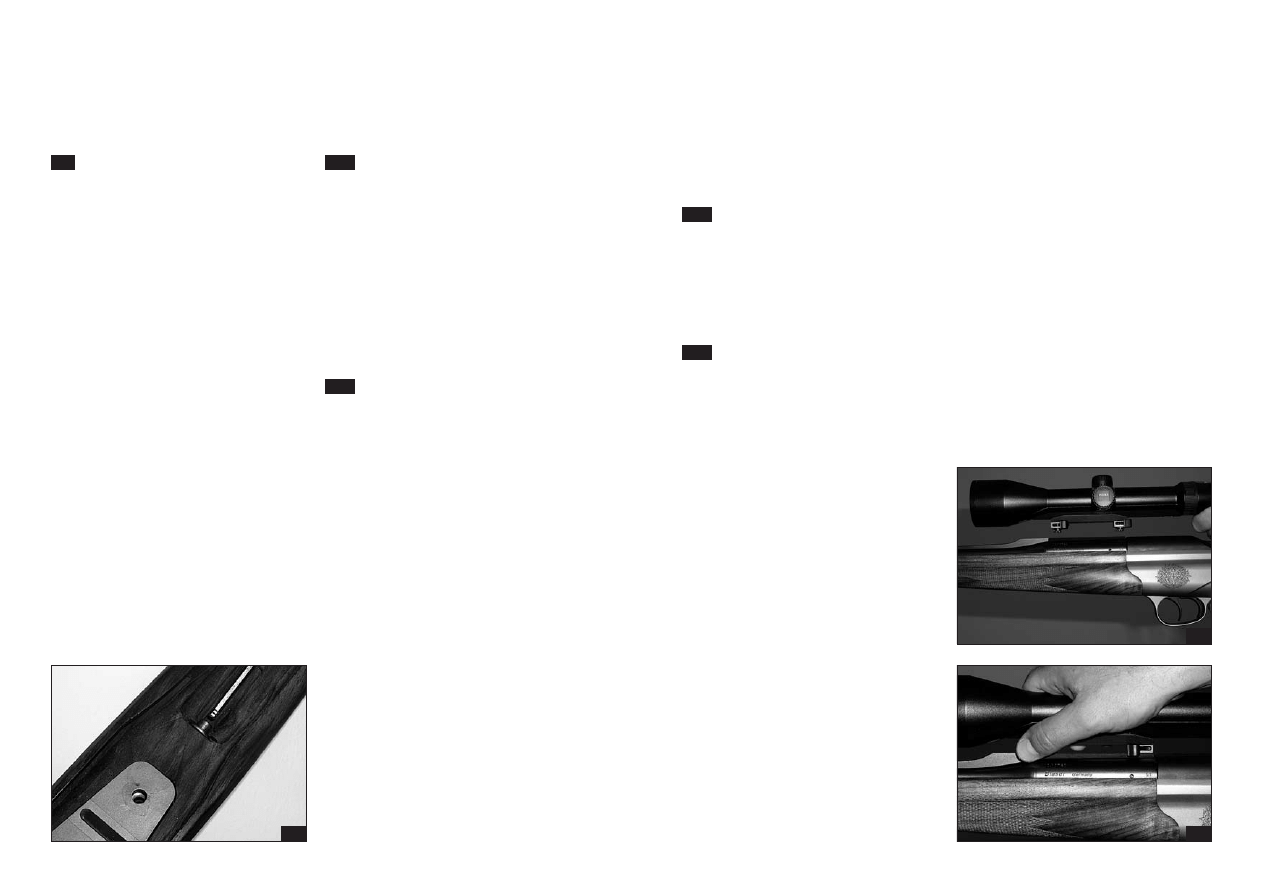
17
16
9. Removal of Forearm /
Exchange of Forearm
10. Open Sights
11. Mounting of Scope
Removal of forearm
Loosen screw in forearm with Allen key
(SW4) and pull forearm off towards the
front.
Mounting forearm
Place forearm on receiver from the front
and tighten screw in forearm.
9.1.
Foresight with elevation
adjustment
• Insert Allen key SW 1.5 into the bore of
the foresight base from above, and turn
Allen screw as needed:
• Foresight (spring-supported)
Turning out = shooting deeper,
Turning in
= shooting higher.
Rear sight with lateral adjustment:
• Slit screw protects rear sight against lateral
adjustment
• To correct left shot
Loosen slit screw, push rear sight to the
right, tighten slit screw.
• To correct right shot
Loosen slit screw, push rear sight to the
left, tighten slit screw.
10.2.
10.1.
Blaser Bolt Action Rifle R 93 Duo is prepared
for the R 93 Duo special mount. We assume
that your scope has been correctly fitted to
the assigned barrel by an authorized Blaser
dealer.
Installing scope
Swivel both locking levers of the mount
backwards. Insert feet of mount into the
bases on the receiver. Fasten mount by
swivelling locking levers forward.
Removing scope
Open locking levers of mount, one after the
other. For this purpose, rotate swivelling
head of locking lever forward, until locking
device is lifted from the groove. Now turn
the entire lever backward.
When both levers have been released, the
scope can be removed by lifting it upwards.
CAUTION:
Do not use force!
Please ensure that the engaging surfaces
are clean!
CAUTION:
If the distance between eye and scope is too
short and if the rifle is not seated correctly
at your shoulder, injuries are not to be exclu-
ded when shooting with large calibres.
Especially in case of big calibres, care has to
be taken that the distance between scope
and eye is appropriate and that the rifle is
seated correctly at the shoulder.
11.2.
11.1.
9.1.
11.1.
11.1.

19
12. Calibre Groups
18
Standard
„ST“:
Magnum
„MA“:
.243 Win.
.308 Win.
.30-06
9,3x62
.300 Win. Mag.
.375 H & H
.416 Rem. Mag.
Calibre groups:
13. Care and
Maintenance
Only use products for the care of your rifle,
which are destined for this purpose.
Barrel set: Polish exterior and interior of
chambers and barrels with a suitable gun oil
after shooting, before storing the rifle for
prolonged periods of time, and after carrying
the rifle, especially in humid or wet con-
ditions. Prior to shooting, barrels and
chambers have to be thoroughly de-oiled
again. In case of thick deposits of bullet
residues, we recommend to use chemical
barrel cleaners.
CAUTION:
Under all circumstances, oberserve
instructions and warnings given by the
product manufacturer for use of product.
Metal parts: Keep all metal parts of the
rifle clean and slightly oiled at all times.
Stock preservative is not suitable
for polishing metal parts!
Stocks: All wooden stocks of Blaser hunting
rifles are oil-rubbed. We recommend to
polish them regularly with standard stock
care products.
Gun oil is not suitable for stock care!
Optics: Please refer to care instructions
of the optics manufacturer.
CAUTION:
When oiling hunting rifles, care has to be
taken that no oil or grease gets into the trigger
and action system. Under certain conditions,
oil and grease can resinify (harden), causing
dangerous disruptions of functioning. Please
have your rifle checked by your specialised
dealer prior to each hunting season or
hunting trip. Every rifle is a piece of technical
equipment requiring regular checks.
14. Warranty Conditions
Ammunition of the same make and charge may
exhibit different efficiency and impact point
characteristics from one manufacturing run to the
other and from one rifle to the other.
When the optimum of ammunition, rifle scope
and mount were selected, we provide a warranty
for the excellent efficiency of our rifles.
Complaints regarding gun efficiency have to be
brought forward in writing within 20 days after
the date of sale. We reserve the right to submit the
rifle to an independent institution for verification
(DEVA or Staatliches Beschussamt) [government
proofhouse]. If excellent gun efficiency is confir-
med there, we are entitled to claim the costs
incurred for the tests from customer.
3. Scope of warranty
Work performed under warranty does not cause
any prolongation or renewal of the warranty period
for the rifle or built in spare parts. The warranty
period for installed spare parts ends at the same
time as the warranty period for the entire rifle.
4. Guarantee exclusion
The guarantee shall be excluded with:
• Damage that is caused as the result of normal
wear and tear, with non-observance of the ope-
rating instructions or improper use or handling
and if the gun shows mechanical damages of
any kind.
• Damages that are the result of force majeure
or environmental influences
• Repairs, treatment or changes to the gun
performed by third parties
• Use of reloaded or non-CIP-permitted
ammunition
• Blueing carried out by a third party
The guarantee does not apply for optical sight
equipment and telescopic sight mounts of manu-
facturers other than Blaser Jagdwaffen GmbH.
More extensive or other claims, especially those
that refer to compensation for damages that go
beyond the gun itself (consequential damages)
shall be excluded (provided liability is not legally
ordered as compulsory).
1. Manufacturer’s warranty
Warranty of Blaser Jagdwaffen GmbH is provided
in addition to statutory warranty claims by dealers,
provided, that the enclosed firearms certificate is
filled in completely and received by Blaser Jagd-
waffen GmbH within ten days after the date of
sale. Warranty is provided exclusively for the first
purchaser having his residence in the country of
purchase.
The warranty applies to the metal and plastic
parts of the rifle only, including original Blaser rifle
scope mounts, but not the rifle scope. Wooden
parts of the rifle require special care and, being
natural products, are subject to natural changes.
Warranty for wooden parts is excluded.
The warranty period amounts to ten years, star-
ting with the date of sale. It includes any defects
of and damages to the rifle (metal and plastic
parts), which are proven to be due to faulty mate-
rial or manufacturing. Within this framework, the
manufacturer shall bear the costs for material and
working time. For performance of work under
this warranty, the rifle has to be returned to the
specialised dealer or the production company in
Isny.
Risk and costs of transportation of the rifle (out-
ward and return) shall be borne by the customer.
Warranty is performed in the discretion of manu-
facturer by repair or replacement of defective
parts; replaced parts pass into manufacturer’s
property.
2. Warranty for gun efficiency
The firing precision of a gun depends on a multi-
tude of factors. The most important factor is the
ammunition. Not every barrel fires equally well
with every type of ammunition, there may be con-
siderably differences in efficiency. The scope and
its mount are of the same importance. Parallax,
loose reticles, defects in reticle adjustment and
faulty mounting are the most common causes for
unsatisfactory gun efficiency. For these reasons,
you should use branded scopes, mounted by a
specialist, and you should tune in the ammunition
to your rifle by testing several types of ammunition.
6-2005 Subject to technical modifications
Calibre:
Wyszukiwarka
Podobne podstrony:
Blaser R93 Lrs 2
Blaser R93
G DUO Specyfikacja PL
Conlit DUO AT 15 3262
0393 dziewczyna w bikini duo night AS4MQP3DNVVXWDNWWF3OYKCKYJOCFRMMTUFZKSY
Antenna Guide G DUO A5 a
Dvorak Humoreske n7 Violin duo
Ling Ling Duo instr 2009 07 20
793 DUO Lovelace Merline Lot do miłości
Conlit Duo certyfikat zgodnosci
PRZEZNACZENIE DUO FENIKS, Teksty 285 piosenek
Monteverdi Duo Seraphim Clamabant (11)
Butisan Duo 400 EC
DUO, OPOWIASTKI
NA KRAWĘDZI DNIA Duo Fenix, Teksty 285 piosenek
GWIAZDKA. Duo Bayres, Teksty 285 piosenek
Cw 9 DUO, Politechnika Lubelska, Studia, Studia, sem III, pen, METODY NUMERYCZNE, Scilab
Conan Solo and Duo Play
ŻYCZYMY SZCZĘŚCIA. Duo Fenix, Teksty 285 piosenek
więcej podobnych podstron